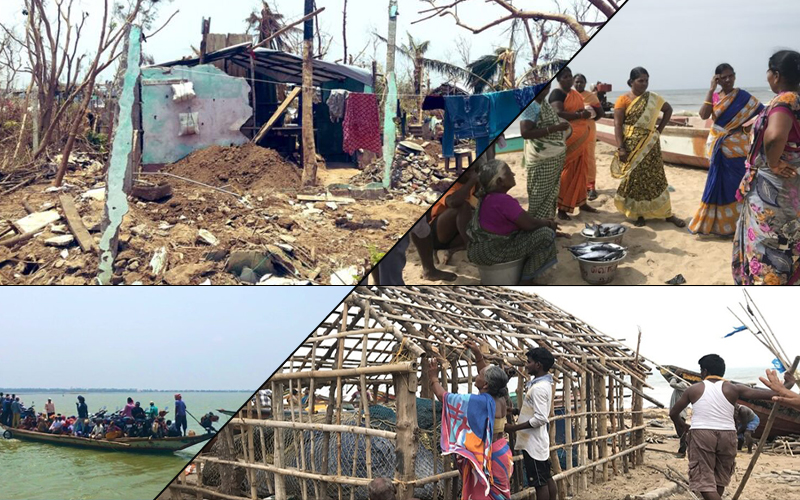 Indian Ocean
Indian Ocean
Rapidly warming Indian Ocean hurtling towards near-permanent marine heatwave state
Marine heatwaves are events where ocean temperatures rise to extreme levels and hold steady for at least five days. These heat waves, that occur over the ocean, are likely to extend to 220-250 days a year by 2050, warns a new study. With increasing marine heatwaves, cyclones can intensify, putting fisheries and people living along the coastline, at risk, reports Mongabay India writer Nidhi Jamwal
In the peak of summer, with heat waves sweeping several parts of India, seven-phase general elections are underway in the world’s biggest democracy. The weather department and the government agencies have been regularly issuing alerts and warnings, to ensure the safety of citizens who step out to cast their votes, amid fear of heat strokes and heat-related illnesses as temperatures rise and heatwaves turn deadlier.
But heat waves are rising not just on land. Globally, marine heat waves are registering a growing trend. A recent study titled Future Projections for the Tropical Indian Ocean has found that the Indian Ocean is warming rapidly and moving towards a state of near-permanent marine heat waves, with 220-250 days of heat waves projected in a year until 2050.
The findings of this new research, led by Roxy Mathew Koll, scientist with Climate Research Lab, Indian Institute of Tropical Meteorology (IITM), Pune, are published in a recent book, The Indian Ocean and its Role in the Global Climate System, released on April 26.
“In the present-day climate scenario, where we are experiencing 1.2-degree Celsius warming, marine heat waves have already emerged in the Indian Ocean and are rising; at present, they range up to 20 days a year,” said Koll, talking to Mongabay India about the implications of prolonged marine heatwaves in the Indian Ocean. “But, by 2050, we are expected to breach the two-degree Celsius mark, and these heatwaves are likely to increase to 220-250 days, which is two-thirds of a year. We are calling it a permanent heat wave state for the Indian Ocean,” he said.
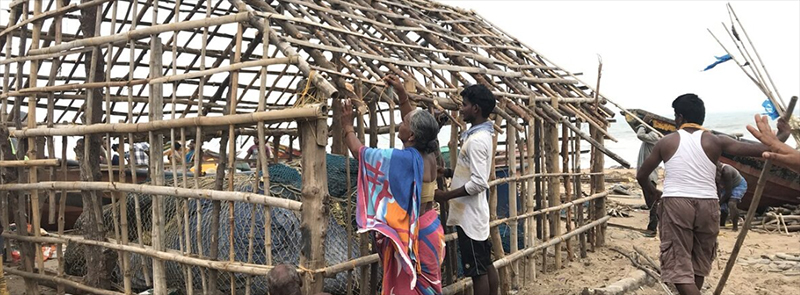 People rebuilding a house after destruction caused due to Cyclone Fani in 2019 when it hit Puri in Odisha. Due to rising marine heatwaves, cyclones are likely to intensify. Photo by Nidhi Jamwal.
People rebuilding a house after destruction caused due to Cyclone Fani in 2019 when it hit Puri in Odisha. Due to rising marine heatwaves, cyclones are likely to intensify. Photo by Nidhi Jamwal.
“These prolonged marine heatwaves will not only intensify cyclones but also affect fish migration, coral reefs, phytoplanktons and marine biodiversity,” warned Koll, who is also the lead author of the Intergovernmental Panel on Climate Change (IPCC) Special Report on the Ocean and Cryosphere in a Changing Climate.
The projected heat waves in the Indian Ocean are of concern as nearly 250 million people live within 50 km of the Indian coastline (3.5% of the world’s population). The 8,118-km long coastline is also home to more than seven million people who depend on fishing for their livelihood.
Rising marine heatwaves in the Indian Ocean
Global warming is leading to rapid warming of the oceans as these vast water bodies store an estimated 91% of the excess heat energy trapped in the earth’s climate system by excess greenhouse gases.
The term ‘marine heatwave’ is relatively new. It was first used to describe an extreme surface warming event off the west coast of Australia during 2010-11 austral summer. Thereafter, it was first identified in 2013 when it resulted in mass mortalities in marine mammals and birds, and the collapse of fisheries and aquaculture in Korea and the U.S.
Marine heatwaves are defined as events where ocean temperatures rise to extreme levels and hold steady for at least five days. In the recent study led by Koll, marine heatwaves are defined as periods of extremely high temperatures, i.e., sea surface temperature (SSTs) exceeding the seasonally-varying 90th percentile threshold based on the 1970–1999 reference period or hotter than 90% of the typical temperatures for each season.
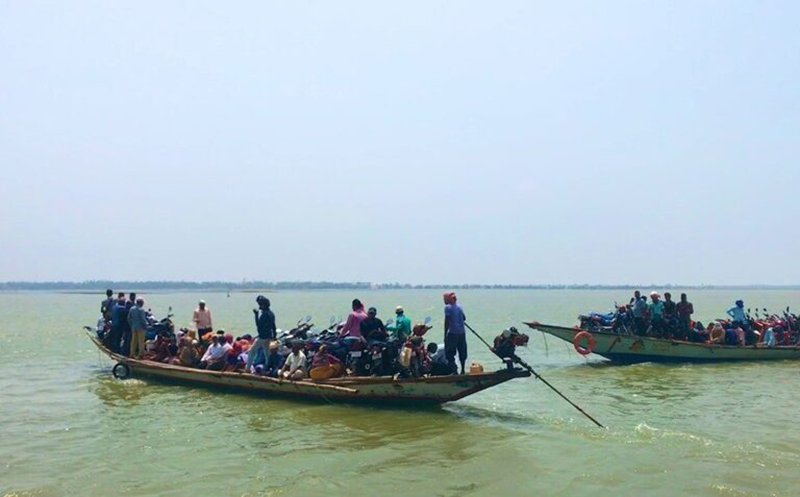 India has a long coastline and around seven million people depend on fishing and allied activities. Marine heatwaves are a direct threat to their livelihood. Photo by Nidhi Jamwal.
India has a long coastline and around seven million people depend on fishing and allied activities. Marine heatwaves are a direct threat to their livelihood. Photo by Nidhi Jamwal.
In recent decades, the tropical Indian Ocean has experienced a rapid increase in ocean warming with an average rise in SST of about one degree Celsius over the period of 1951-2015 at a rate of 0.15 degree Celsius per decade. Research shows that the western Indian Ocean had a total of 66 marine heat wave events while the Bay of Bengal had 94 events during the 1982-2018 period.
Further, the western Indian Ocean region experienced a four-fold rise in marine heat wave events (increasing at a rate of 1.5 events per decade) and the north Bay of Bengal experienced a two-to-three-fold rise (at a rate of 0.5 events per decade), according to Jitendra Singh, the then Minister of State for Earth Science, in a written reply in Rajya Sabha in 2022.
Climate scientists are worried about the ‘near-permanent marine heatwave’ in the Indian Ocean.
“Due to global warming, all the global ocean basins are warming up. The Indian Ocean is warming much faster than other basins. For tropical cyclone intensification, oceans play an important role,” M. Rajeevan, one of India’s top climate scientists and former secretary of the Ministry of Earth Sciences, told Mongabay India.
“Ocean heat content, which is heat content in the ocean waters say up to 100 metre or so, and other atmospheric conditions influence cyclone intensification. With increasing SSTs and ocean heat content, there is a tendency for cyclones to intensify quickly once a storm develops. This is seen in all ocean basins. With future projections, this tendency will only increase in the future,” he explained.
According to Koll, the average sea surface temperature in the Bay of Bengal is between 28 and 30 degrees Celsius. During a marine heatwave, this temperature can reach up to 31-32 degrees Celsius. “Through in-situ ocean measurement, we saw temperatures reaching up to 34 degrees Celsius in the Bay of Bengal, which is the highest recorded temperature anywhere in the open oceans,” he said.
“The 33-34 degrees Celsius marine heatwave preceded Cyclone Amphan in May 2020, which is one of the strongest cyclones in the history of the Bay of Bengal,” he added.
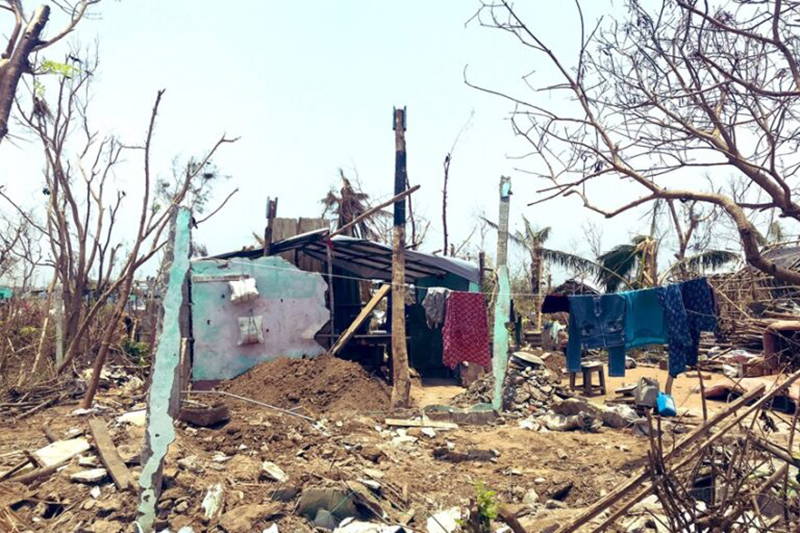 The destruction caused by Cyclone Fani in 2019 when it hit Puri in Odisha. Extremely warm waters act as a strong source of heat and moisture, helping cyclones to intensify rapidly. Photo by Nidhi Jamwal.
The destruction caused by Cyclone Fani in 2019 when it hit Puri in Odisha. Extremely warm waters act as a strong source of heat and moisture, helping cyclones to intensify rapidly. Photo by Nidhi Jamwal.
According to him, experts who have been monitoring ocean temperatures for a very long time are shocked to record such extreme temperatures.
Increasing cyclone intensity
Higher water temperatures associated with marine heat waves can cause extreme weather events such as tropical storms and cyclones and disrupt the water cycle, making floods, droughts, and wildfires on land more likely. Extremely warm waters act as a strong source of heat and moisture, helping cyclones to intensify rapidly.
Another recent paper by Koll, on heat waves, notes that between 1980 and 2020, about 90% of the cyclones in the Bay of Bengal and Arabian Sea were preceded by marine heatwaves. “Marine heatwaves are intensifying cyclones which go through a stage of rapid intensification wherein a cyclone goes from category 1 cyclone to category 3 or category 5 cyclone in a short duration of time,” explained Koll.
At present, the Saffir-Simpson Hurricane Wind Scale rates a cyclone’s strength from category 1 to category 5. Category 1 cyclones have wind speeds between 119–153 km per hour. Category 2 has wind speeds between 154–177 km per hour; Category 3 includes wind speeds between 178–208 km per hour; Category 4 is between 209–251 km per hour; and Category 5 is greater than or equal to 252 km per hour.
According to Rajeevan, since there is a clear tendency of increasing tropical cyclone intensity, the present classification of cyclones using five categories may not serve the purpose. “If we want to convey the seriousness of this issue, we need to add one more category of category 6 cyclones to warn the people appropriately,” he said.
Fishers on the edge
“Fishing communities are already living on the edge. Various development projects on the coast are encroaching on fishing villages and worksites of fishers. They are also polluting the sea. And global warming and marine heatwaves are worsening their plight,” said D. Paul of the Democratic Traditional Fish Workers Forum, Andhra Pradesh.
According to Paul, rising frequency and intensity of cyclones is a direct threat to the livelihood of fishers, considering there is already an annual fishing ban of 61-day around the monsoon on both the coasts of the country, including Andaman & Nicobar Islands and Lakshadweep. All fishing activities are banned during this period except traditional non-motorised boats, which can continue fishing.
On the east coast of the country, this ban comes into force from April 15 till June 14, whereas on the west coast, it starts from June 1 and ends on July 31.
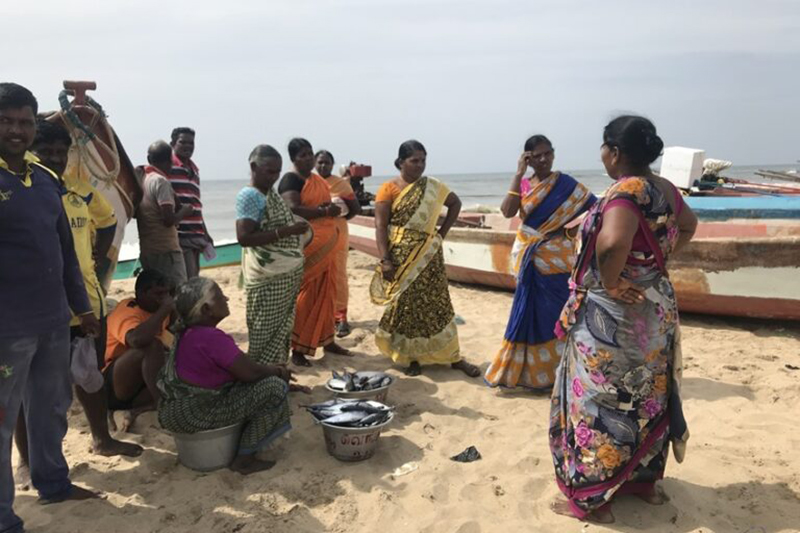 Rising frequency and intensity of cyclones is a direct threat to the livelihood of fishers. Photo by Nidhi Jamwal.
Rising frequency and intensity of cyclones is a direct threat to the livelihood of fishers. Photo by Nidhi Jamwal.
“On paper, a fishing family is eligible for a compensation of Rs. 10,000 for two months during the fishing ban. But many do not receive it. During cyclones, fishers again cannot go to sea and cyclones are on the rise. How will the fishing communities cope?” asked Paul.
According to Koll, the livelihoods of coastal fishing communities are at risk. “Because of the warming of the waters of the Arabian Sea, algal bloom is taking place. Fish migration is also being affected. Fishes migrate from the equator to poleward, or they dive down for cooler waters. But because the sea surface temperature becomes warm compared to subsurface waters, it prevents the mixing of water, which is important because the nutrients for microscopic plants are in the subsurface,” he told Mongabay India.
A 2015 study published in Geophysical Research Letters reported a decrease of up to 20% in phytoplankton – microscopic marine algae that serves as food for marine life – in the western Indian Ocean region over the past six decades. According to the authors, this reduction is due to the warming of the ocean.
Prolonged marine heatwaves are also a risk to coral reefs. “Coral reefs occupy only less than one percent of the ocean surface, but they are key to the survival of a quarter of the marine species. Corals have a mucous membrane, which gives them bright colours and protects them from diseases. Due to extreme temperatures, this membrane peels off and exposes the skeleton of the corals, and they can get killed. This is already happening in the Indian Ocean,” said Koll.
According to Rajeevan, there is a need to develop a good strategy for mitigating the risks of storm surges and heavy rains, coastal flooding, and coastal erosion. “We need to improve our early warning systems and bring in many societal developments. Even if there is a warming, people don’t move out because they are afraid of losing their life-long earnings. A disaster management system, even though well advanced with the latest technology, will not serve the purpose if we do not take care of human or societal dimensions.”
(The story was originally published in Mongabay India.)
Support Our Journalism
We cannot do without you.. your contribution supports unbiased journalism
IBNS is not driven by any ism- not wokeism, not racism, not skewed secularism, not hyper right-wing or left liberal ideals, nor by any hardline religious beliefs or hyper nationalism. We want to serve you good old objective news, as they are. We do not judge or preach. We let people decide for themselves. We only try to present factual and well-sourced news.







